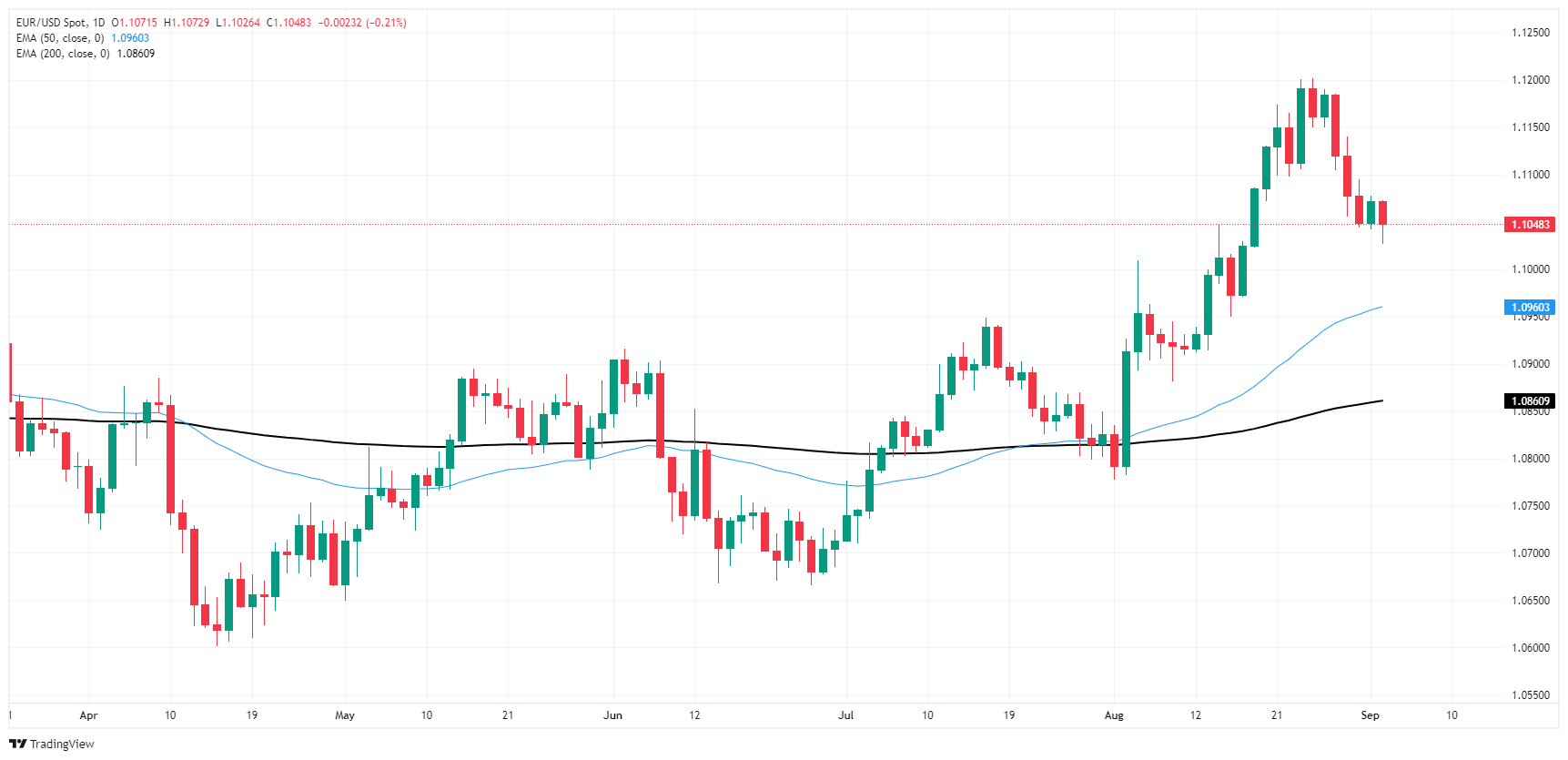EUR/USD continues to find a technical foothold, but downside pressure is mounting


- EUR/USD managed to keep a hold of 1.1050 on Tuesday, but action is tilted downside.
- US PMI figures that flubbed forecasts stoked a fresh bid into the Greenback.
- US NFP labor numbers due this week will be a guiding print for Fed rate cut depth.
EUR/USD tilted further into the low side on Tuesday, with intraday bottom bids testing into two-week lows before settling the day near 1.1050 once again. Price action remains limited as markets gear up for one last US Nonfarm Payrolls (NFP) print this week, but a flop in US ISM Purchasing Managers Index (PMI) figures reignited fears of an impending recession.
Forex Today: The prospects of a US soft landing remain challenged by data
Meaningful European data remains limited in the front half of the trading week, and Thursday will see Fiber traders with their hands full thanks to an update to pan-European Retail Sales in July followed by US preview labor figures before Friday’s NFP jobs dump.
Pan-EU Retail Sales for the year ended in July are expected to recovery slightly, forecast to print at 0.1% YoY compared to the previous period’s -0.3% decline. European Gross Domestic Product (GDP) figures are also slated for Friday, and growth is broadly expected to hold steady at previous figures in the second quarter.
ISM’s US Manufacturing PMI for August came in below expectations, printing at 47.2 and missing the median market forecast of 47.5. Despite a soft rebound from July’s multi-month low of 46.8 failed to galvanize markets, giving already flighty investors a perfect excuse to pull back from a recent lopsided tilt into bullish expectations.
Friday's US Nonfarm Payrolls (NFP) report looms large. It represents the last round of key US labor data before the Federal Reserve (Fed) delivers its latest rate call on September 18. Friday's NFP print is widely expected to set the tone for market expectations regarding the depth of a Fed rate cut, with investors fully priced in on the start of a new rate-cutting cycle this month.
EUR/USD price forecast
Fiber has slumped back into near-term technical barriers, but bidders continue to come out of the woodwork in an effort to keep bids on-balance even if they can’t quite pull out a bullish recovery.. EUR/USD popped into a 13-month high just above 1.1200 early last week, and a near-term pullback in Greenback flows sees bids scrambling to hold onto bullish chart paper.
The pair is still trading well north of the 200-day Exponential Moving Average (EMA) at 1.0845. Despite holding deep in the bull country, EUR/USD is still facing a steepening bearish pullback as shorts congregate targets just above the 50-day EMA at 1.0956.
EUR/USD daily chart
Euro FAQs
What is the Euro?
The Euro is the currency for the 20 European Union countries that belong to the Eurozone. It is the second most heavily traded currency in the world behind the US Dollar. In 2022, it accounted for 31% of all foreign exchange transactions, with an average daily turnover of over $2.2 trillion a day. EUR/USD is the most heavily traded currency pair in the world, accounting for an estimated 30% off all transactions, followed by EUR/JPY (4%), EUR/GBP (3%) and EUR/AUD (2%).
What is the ECB and how does it impact the Euro?
The European Central Bank (ECB) in Frankfurt, Germany, is the reserve bank for the Eurozone. The ECB sets interest rates and manages monetary policy. The ECB’s primary mandate is to maintain price stability, which means either controlling inflation or stimulating growth. Its primary tool is the raising or lowering of interest rates. Relatively high interest rates – or the expectation of higher rates – will usually benefit the Euro and vice versa. The ECB Governing Council makes monetary policy decisions at meetings held eight times a year. Decisions are made by heads of the Eurozone national banks and six permanent members, including the President of the ECB, Christine Lagarde.
How does inflation data impact the value of the Euro?
Eurozone inflation data, measured by the Harmonized Index of Consumer Prices (HICP), is an important econometric for the Euro. If inflation rises more than expected, especially if above the ECB’s 2% target, it obliges the ECB to raise interest rates to bring it back under control. Relatively high interest rates compared to its counterparts will usually benefit the Euro, as it makes the region more attractive as a place for global investors to park their money.
How does economic data influence the value of the Euro?
Data releases gauge the health of the economy and can impact on the Euro. Indicators such as GDP, Manufacturing and Services PMIs, employment, and consumer sentiment surveys can all influence the direction of the single currency. A strong economy is good for the Euro. Not only does it attract more foreign investment but it may encourage the ECB to put up interest rates, which will directly strengthen the Euro. Otherwise, if economic data is weak, the Euro is likely to fall. Economic data for the four largest economies in the euro area (Germany, France, Italy and Spain) are especially significant, as they account for 75% of the Eurozone’s economy.
How does the Trade Balance impact the Euro?
Another significant data release for the Euro is the Trade Balance. This indicator measures the difference between what a country earns from its exports and what it spends on imports over a given period. If a country produces highly sought after exports then its currency will gain in value purely from the extra demand created from foreign buyers seeking to purchase these goods. Therefore, a positive net Trade Balance strengthens a currency and vice versa for a negative balance.






.jpg)